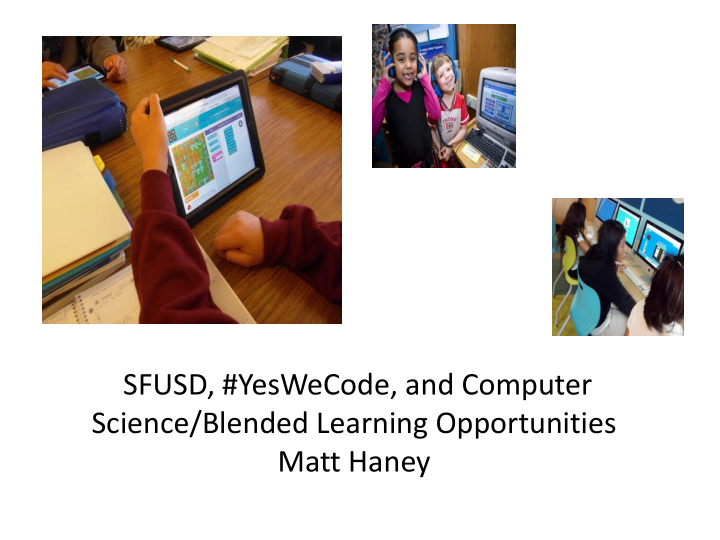



SFUSD, #YesWeCode, and Computer Science/Blended Learning Opportunities Matt Haney
2 San Francisco City is booming, and key challenges must be 2 addressed for all residents to thrive Challenges Positive economic trends • 4.0% job growth in 2012 More jobs, Rising income inequality • Expected five-year job growth: 11.9% many in high • More than 50,000 engineers in SF paying • Fastest growing jobs sector: Information sectors.. Rising poverty rate • …leading to Median household income of $78,000 Unaffordable housing • rising Expected five year personal income growth: incomes… 24.1% Lack of diversity in the workforce …and more • $937,000 median home prices Too few college- and career- housing • 14.6% increase in median home price ready HS graduates wealth Sources: Data Quick; California DOT; Boston Consulting Group; , Forbes
1,000,000 Unfilled Jobs by 2020 1,600,000 1,400,000 $500 billion 1,200,000 opportunity 1,000,000 800,000 1,000,000 unfilled programming jobs 600,000 400,000 400,000 computer 200,000 science graduates - 2011 2012 2013 2014 2015 2016 2017 2018 2019 2020 Sources: BLS, NSF, Bay Area Council Economic Institute
The Job/Student Gap Computer Science Students Computing Jobs 2% All other math and science jobs 60% STUDENTS JOBS 40% All other math and science students 98% Sources: College Board, Bureau of Labor Statistics, National Science Foundation
Why Expand CS Education? CS teaches important, transferable skills. creative innovative cooperative problem thinking learning solving source: Level Playing Field Institute 5
SFUSD’s Plan: Expand computer science education to all students at all schools, beginning in pre- kindergarten and extending through 12th grade. 6
Current State of CS in SFUSD 6-8 9-12 PK-5 ● Zero schools ● Two schools ● Ten schools offer dedicated offer dedicated offer ongoing CS CS electives. CS electives. instruction. ● Impact: 0.5% ● Impact: 5% ● Impact: 0% of all 6-8 students of all 9-12 students of all PK-5 students fragmented and voluntary → lack of equity and uneven quality 7
Goals by Level 6-8 • 9-12 PK-5 ● ● Provide instruction to Provide instruction to all ● Offer introductory and all students. students. AP courses to all students at all schools. ● Make instruction ● Generate excitement engaging, relevant, about computing. Double AP participation. ● creative, and ● Develop problem solving ● Broaden participation, collaborative. and critical thinking skills. to represent student Develop strong ● population as a whole. ● Foster creativity and foundational knowledge collaboration. and skills. ● Explore issues raised by societal impacts of computing. 8
OPPORTUNITY PIPELINE STRATEGY
Vision To train 100,000 low-opportunity youth to become high-level computer programmers
The Opportunity #YesWeCode Opportunity Tech Demand for Pipeline taps workforce trained tech into hidden diversity workers genius of challenge black/brown communities • America needs trained tech There is a lack of diversity workers : The Bureau of Labor in the tech sector : Earlier Statistics projects that there will be this year, Google reported that more than 1.4 million jobs created by 70% of its employees are 2020 that require computer science male and 61% are white. This and programming skills, but only is especially true for the “technical talent” areas of the 400,000 computer science sector compared to the “non - graduates to fill those jobs. tech” roles in companies, like Furthermore, tech workers have been estimated to earn 74 percent Facebook, Google and Twitter. more than non-tech workers. Tech companies recognize • While growth of undergraduate that they are not where they programs is critical, it is inadequate want to be in terms of to meet the growing demand for workforce diversity and more programmers and other tech inclusion. jobs. Also, undergraduate programs are of little help to those already in the workforce.
Training Tomorrow’s Tech Workers Today
Opportunity Pipeline Strategy • Focus on digitally-disenfranchised youth, ages 18-25 , who are job ready and trainable for careers in tech • Focus on bootcamps to accelerate technical skills-building • Focus on apprenticeships to support bootcamp graduates to thrive in a tech workforce
#YES Opportunity Pipeline Strategy First Exposure to Tech Job Securing a Job in First Mile Middle Mile Last Mile Computer Development & Tech Science Training • #YES Employers' Council investing in • Next-gen youth • # YES Diversity fellowships and hackathons Fellowship to access apprenticeships • Broad-based media accelerated learning • #YES Corporate programs (bootcamps) campaigns Advisory Board of C- • #YES Apprenticeships suite leaders committed to connect training to #YesWeCode's graduates to potential vision to empower the employers next-generation of tech leaders, innovators and entrepreneurs
Making It Happen Blended Learning in Secure Care Facilities
Why Blended Learning in Juvenile Facilities? ❏ Increase Student Engagement ❏ Improve Instruction ❏ Individualize, differentiate, offer real-time assessment ❏ Expand Content/Course Offerings--HS and Post Secondary ❏ Connect to job pathways/coding bootcamps ❏ Develop Digital Citizens ❏ Re-invigorate Teachers ❏ Improve Overall Institution and School Climate
Implementation Options: Classroom Device Models Desktops 1:2 Google Apps for Education + Laptop Carts Chromebooks iPads/Tablets Thinking Ahead How do you want to facilitate blended/online learning in residential units?
Potential Next Steps Assess Engage Teachers Empower ➔ survey Infrastructure Leadership ➔ Internet access ➔ toolkit ➔ develop a vision ➔ bandwidth ➔ budget ➔ interest ➔ devices ➔ timeline ➔ training
⥉ Nonprofit devoted to transforming teaching and learning in juvenile justice facilities ⥉ Support blended learning integration ⥉ Work with juvenile justice agencies across the country ⥉ Started by David Domenici, founding principal of the Maya Angelou Academy in Washington, DC Contact Information: Matt Haney, matthaneysf@gmail.com
Recommend
More recommend